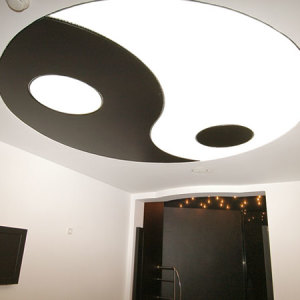When creating suspended ceilings, interior partitions, door arches, other decorative designs from drywall, there is a need for complex processing of this material, namely its flexions. It seems that the leaf bend will not work, as the plaster is very fragile. However, if you know some nuances of working with GLC, you can make a rounded design with any radius.
Processing arched plasterboard. These sheets have a thickness of 6.5 mm, so it is lighter than their solid "relatives" - moisture-proof and wall GLK. In addition, the material is reinforced with fiberglass, which increases its plasticity. Due to high elasticity, with the help of arched plasterboard it is easy to create any curvilinear figure, an arc, a sevenortark, wave-like and duplicate forms. The radius of its bend is much larger than the wall and ceiling GLC. It does not require additional tools. On the other hand, there are some difficulties when working with arched plasterboard - it is harder to cut, because the composition is present fiberglass, heavier to screw the screws, when creating a decorative design, you have to lay two layers of such a material, as it has a small thickness. Thus, to create an arch, it is better not to buy special arched sheets, but to give preference to standard and spend a little more time on their deformation.
Consider in more detail how can be bent drywall in dry:
- Method number 1. To begin with, collect the framework of a future design of metal products, bonding it with a self-drawing. Apply the sheet to the finished skeleton on the one hand. Start bending the material along the frame, at the same time fixing the self-drawing.
- Method number 2. As part of this method, an ordinary sharp knife is used. It is necessary to make parallel cuts on the surface of the plasterboard sheet. Make them perpendicular to bend. They should not reach the inside - the opposite layer of cardboard - about 2 mm. The leaf bending will be more smooth, and the radius is smaller than you often do cuts and the less left the gap between them. When mounting the sheet, cuts should be located on the convex side of the structure: for the arch - on the wrong side, for the column - on the facial. After fixing the material in the design, fill the slots using a gypsum putty.
- Method 3. Instead of a knife, you can adjust the cutter. Stop it to a certain depth so that the choice of almost the entire gypsum occurred. Stay should be 1-3 mm. Make a gypsum sampling more often if you want to get a smaller leaf bending radius.

How can I bend a sheet of HCL using water:
- Method number 1. Moisten one side of the leaf of water temperature using a roller or a brush. It is better to glow several times until the material stops absorbed it. However, it is important not to rearrange and prevent complete turning of the sheet, make sure that its one side remains dry. Gypsum is a porous material, so quickly absorbed moisture and becomes softer. After 5-15 minutes, you will be able to bend it - to do this, attach it to metal rolls with self-draws. When the material is dry - the acquired form will be preserved, and you can move to its putty. At the same time, remember that this method is not suitable if it is necessary to obtain a small bend radius, since the plasterboard can simply crack.
- Method number 2. In the situation with a small bend radius, it is recommended to use a special needle roller on a long handle that has metal spikes. For one-time work, you can do the ships. Walk to them from the other side of the sheet, which in the future will be concave, blasting cardboard with a small layer of plaster. The grilted GLC is even easier if you mix it with water from the perforated side.
That's all about the correct bending of plasterboard. It remains to proceed to practice - create a frame or box, to decide the design of the drywall form and sharpen. Work slowly, without a rush, as GKC is a fragile material, it can crack, burst or breaking out that the promises for the hosts additional costs.

































